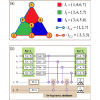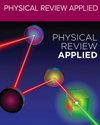Logical quantum circuits protected by the Steane code for specific noises in trapped ions
IF 4.4
2区 物理与天体物理
Q2 PHYSICS, APPLIED
引用次数: 0
Abstract
In the presence of physical noise of all platforms for quantum computation, quantum error correction (QEC) becomes a critical way to realize quantum algorithms with large quantum volumes. In order to understand the influence of quantum noise on QEC codes and further improve the performance of logical circuits, the noises should be accurately analyzed with proper models. Here we focus on the trapped-ion system. Fundamentally, we start from the laser pulses of the quantum gates in the circuits and extract the noise components from the complete evolution of the quantum states, beyond the standard depolarizing model and other simplified models. Our simulations indicate that the logical performance under real noises is significantly better than that predicted by previous models. Meanwhile, the advantage of QEC is shown in the levels of one, two, and more logical qubits. Moreover, we can increase the logical fidelity by the method of ion mapping, which is based on knowledge of the specific noise distribution of different ions. Some powerful evidence from the numerical results demonstrates the possibility to access fault-tolerant quantum computation with the trapped-ion system.

受困离子中特定噪声的 Steane 代码保护的逻辑量子电路
在所有量子计算平台都存在物理噪声的情况下,量子纠错(QEC)成为实现大量子量子算法的关键途径。为了理解量子噪声对 QEC 代码的影响并进一步提高逻辑电路的性能,应该用适当的模型对噪声进行精确分析。在此,我们重点讨论困离子系统。从根本上说,我们从电路中量子门的激光脉冲出发,从量子态的完整演化过程中提取噪声成分,超越了标准去极化模型和其他简化模型。我们的模拟表明,真实噪声下的逻辑性能明显优于以往模型的预测。同时,QEC 的优势还体现在一个、两个和更多逻辑量子比特的层面上。此外,我们还可以通过离子映射的方法提高逻辑保真度,这种方法是基于对不同离子特定噪声分布的了解。一些来自数值结果的有力证据表明,利用困离子系统进行容错量子计算是可行的。
本文章由计算机程序翻译,如有差异,请以英文原文为准。
求助全文
约1分钟内获得全文
求助全文
来源期刊

Physical Review Applied
PHYSICS, APPLIED-
CiteScore
7.80
自引率
8.70%
发文量
760
审稿时长
2.5 months
期刊介绍:
Physical Review Applied (PRApplied) publishes high-quality papers that bridge the gap between engineering and physics, and between current and future technologies. PRApplied welcomes papers from both the engineering and physics communities, in academia and industry.
PRApplied focuses on topics including:
Biophysics, bioelectronics, and biomedical engineering,
Device physics,
Electronics,
Technology to harvest, store, and transmit energy, focusing on renewable energy technologies,
Geophysics and space science,
Industrial physics,
Magnetism and spintronics,
Metamaterials,
Microfluidics,
Nonlinear dynamics and pattern formation in natural or manufactured systems,
Nanoscience and nanotechnology,
Optics, optoelectronics, photonics, and photonic devices,
Quantum information processing, both algorithms and hardware,
Soft matter physics, including granular and complex fluids and active matter.
 求助内容:
求助内容: 应助结果提醒方式:
应助结果提醒方式:


